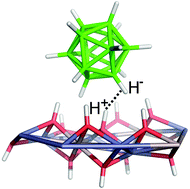当前位置:
X-MOL 学术
›
Dalton Trans.
›
论文详情
Our official English website, www.x-mol.net, welcomes your
feedback! (Note: you will need to create a separate account there.)
Outerly functionalized and non-functionalized boron clusters intercalated into layered hydroxides with different modes of binding: materials for superacid storage
Dalton Transactions ( IF 3.5 ) Pub Date : 2018-08-07 00:00:00 , DOI: 10.1039/c8dt02251h Klára Melánová 1, 2, 3 , Josef Holub 3, 4, 5 , Jan Hynek 3, 4, 5 , Jindřich Fanfrlík 3, 6, 7 , Ludvík Beneš 3, 8, 9, 10 , Petr Kutálek 3, 8, 9, 10 , Anna Krejčová 3, 8, 9, 10 , Drahomír Hnyk 3, 4, 5 , Vítězslav Zima 1, 2, 3
Dalton Transactions ( IF 3.5 ) Pub Date : 2018-08-07 00:00:00 , DOI: 10.1039/c8dt02251h Klára Melánová 1, 2, 3 , Josef Holub 3, 4, 5 , Jan Hynek 3, 4, 5 , Jindřich Fanfrlík 3, 6, 7 , Ludvík Beneš 3, 8, 9, 10 , Petr Kutálek 3, 8, 9, 10 , Anna Krejčová 3, 8, 9, 10 , Drahomír Hnyk 3, 4, 5 , Vítězslav Zima 1, 2, 3
Affiliation

|
Two binary boron hydrides (NH4)2B10H10 and Na2B12H12 and mono- and dicarboxy p- and m-carboranes (namely, 1-(COOH)-closo-1,7-C2B10H11, 1,12-(COOH)2-closo-1,12-C2B10H10 and 1,7-(COOH)2-closo-1,7-C2B10H10) were intercalated into ZnAl-layered double hydroxides (ZnAl-LDH) and into Zn5(OH)8(NO3)2·2H2O. The formed compounds were characterized using elemental analysis, thermogravimetry analysis, X-ray powder diffraction, infrared spectroscopy and solid state NMR. All the intercalated boron compounds are present in the interlayer space of the layered hosts as anions. It is presumed that in the case of B10H102−, B12H122− and 1,12-(COO)2-closo-1,12-C2B10H102−, the guest molecules form a monolayer, whereas in the case of 1-(COO)-closo-1,7-C2B10H111− and 1,7-(COO)2-closo-1,7-C2B10H102− a bilayer arrangement is more probable. In the case of 1,7-(COO)2-closo-1,7-C2B10H102−, the guest molecules are strongly interdigitated resulting in lowering of the interlayer distance. Two different modes of binding were found. Whereas the carboxylate derivatives of p- and m-carboranes are bonded through classical hydrogen bonds, the corresponding parent borane anions interact with the host structures by mainly dihydrogen bonding. In effect, both kinds of hydrogen bonding are mainly of an electrostatic nature. The dihydrogen bond is detected, e.g. in crystal engineering, and represents a driving force for interactions of boranes with biomolecules. Since the latter dicarboxylic acids were found to be superacids, their interactions with the host structures should be stronger than in the case of the benzoic and terephthalic acid intercalates.
中文翻译:

外部官能化和非官能化的硼团簇插入具有不同结合方式的层状氢氧化物中:超酸存储材料
两个二进制硼氢化物(NH 4)2乙10 ħ 10和Na 2乙12 ħ 12和单-和二羧基p -和米-carboranes(即,1-(COOH) -闭合碳-1,7--C 2乙10 ħ 11,1,12-(COOH)2 -闭合碳-1,12-C 2乙10 ħ 10和1,7-(COOH)2 -闭合碳-1,7--C 2乙10 ħ 10)插入ZnAl层状双氢氧化物(ZnAl-LDH)和Zn 5(OH)8(NO 3)2 ·2H 2 O中。形成的化合物用元素分析,热重分析,X射线粉末衍射,红外光谱和固态NMR。所有嵌入的硼化合物都以阴离子形式存在于层状主体的层间空间中。据推测,在B的情况下10 ħ 10 2-,B 12 ħ 12 2-和1,12-(COO)2 -闭合碳-1,12-C 2乙10 ħ10 2-,客体分子形成单层,而在1-情况下(COO) -闭合碳-1,7--C 2乙10 ħ 11 1-和1,7-(COO) 2 -闭合碳-1, 7-C 2 B 10 H 10 2-更有可能是双层结构。在1,7-(COO)的情况下, 2 -闭合碳-1,7--C 2乙10 ħ 10 2-,客体分子强烈相互交叉从而在层间距离降低。发现了两种不同的结合方式。而p的羧酸酯衍生物-和m-碳硼烷通过经典的氢键键合,相应的母体硼烷阴离子主要通过二氢键与主体结构相互作用。实际上,两种氢键都主要具有静电性质。例如在晶体工程中检测到二氢键,该氢键代表硼烷与生物分子相互作用的驱动力。由于发现后者的二羧酸是超酸,因此它们与主体结构的相互作用应强于苯甲酸和对苯二甲酸嵌入物的情况。
更新日期:2018-08-07
中文翻译:

外部官能化和非官能化的硼团簇插入具有不同结合方式的层状氢氧化物中:超酸存储材料
两个二进制硼氢化物(NH 4)2乙10 ħ 10和Na 2乙12 ħ 12和单-和二羧基p -和米-carboranes(即,1-(COOH) -闭合碳-1,7--C 2乙10 ħ 11,1,12-(COOH)2 -闭合碳-1,12-C 2乙10 ħ 10和1,7-(COOH)2 -闭合碳-1,7--C 2乙10 ħ 10)插入ZnAl层状双氢氧化物(ZnAl-LDH)和Zn 5(OH)8(NO 3)2 ·2H 2 O中。形成的化合物用元素分析,热重分析,X射线粉末衍射,红外光谱和固态NMR。所有嵌入的硼化合物都以阴离子形式存在于层状主体的层间空间中。据推测,在B的情况下10 ħ 10 2-,B 12 ħ 12 2-和1,12-(COO)2 -闭合碳-1,12-C 2乙10 ħ10 2-,客体分子形成单层,而在1-情况下(COO) -闭合碳-1,7--C 2乙10 ħ 11 1-和1,7-(COO) 2 -闭合碳-1, 7-C 2 B 10 H 10 2-更有可能是双层结构。在1,7-(COO)的情况下, 2 -闭合碳-1,7--C 2乙10 ħ 10 2-,客体分子强烈相互交叉从而在层间距离降低。发现了两种不同的结合方式。而p的羧酸酯衍生物-和m-碳硼烷通过经典的氢键键合,相应的母体硼烷阴离子主要通过二氢键与主体结构相互作用。实际上,两种氢键都主要具有静电性质。例如在晶体工程中检测到二氢键,该氢键代表硼烷与生物分子相互作用的驱动力。由于发现后者的二羧酸是超酸,因此它们与主体结构的相互作用应强于苯甲酸和对苯二甲酸嵌入物的情况。











































 京公网安备 11010802027423号
京公网安备 11010802027423号